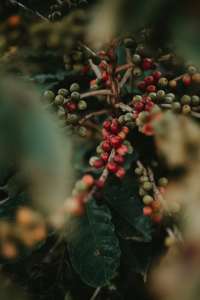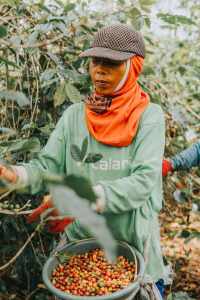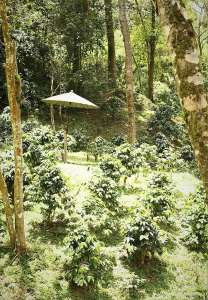Coffee is the second most consumed beverage on earth with over 2 billion cups consumed every day.
It’s also a valuable commodity and in 2023 the global market was worth over USD$93 billion (£74 billion).
Now, with their smooth taste and many varieties, arabica coffee beans make up around 60%-70% of global coffee production.
Coffee cultivation also directly supports the livelihoods of 25 million family farmers.These farms also support another 100 million people involved in coffee processing and retailing.
But like many other plants, coffee crops are also threatened by climate change in many parts of the world.
Experts say that there’s a growing need for selective breeding to help crops adapt to new conditions.
Such a method is also crucial for growing coffee in less accommodating areas–like ones affected by drought.
Learning from another coffee-grower

In the highlands of the Ethiopian plateau, a vibrant tree that grows red cherries has become a part of people’s lives worldwide.
The cherries are of course seeds which will turn into coffee beans.
Their roots trace back to the native land of coffee trees which usually grows well in the understory of tropical forests.
Therefore, the traditional cultivation of coffee is done in shaded environments as it mirrors its natural habitat. This method has been successful even as coffee production expanded globally.
And as the time goes, other methods of production came up.
They range from rustic mountain cultivation to shaded monocultures and industrial methods. Industrial methods mean unshaded monocultures with intensive management practices.

But in recent times, there’s an increasing awareness of biodiversity decline. So, the focus has shifted back to shaded coffee production.
One might think that areas with coffee farms won’t be as biodiverse. Surprisingly, that’s not the case (if the farms are managed well).
There are coffee farm regions which boast some of the Earth’s highest biodiversity levels.
In these shade systems, coffee plants coexist with many other creatures, from ants and beetles to birds and bats.
The shift towards studying coffee as an agroecosystem, blending natural and agricultural elements, has gained popularity.
And thanks to Ivette Perfecto, an ecologist at the University of Michigan, the agroecosystem might become even more well-known.
Perfecto has played an important role in unraveling the intricate web of species inhabiting coffee farms. The ecologist has particularly highlighted insect inhabitants that are often overlooked.
Coffee farms for biodiversity purposes
Historically, conservation efforts concentrated on protected areas like parks.
But agricultural lands, covering more than double the area of protected zones, present conservation opportunities.
Shaded coffee farms, in particular, can act as refuges supporting wildlife, offering quality habitat beyond traditional protected areas.

Perfecto emphasizes the importance of viewing coffee farms within the context of a bigger landscape.
Biodiversity flourishes when coffee farms coexist with intact natural habitats, especially forests.
With Perfecto’s findings, there’s a shift in perspective that leads to a renewed interest in sustainable farming methods.
By using these methods, coffee farms won’t only meet our daily caffeine demand but also help nurture biological diversity.
The effects of farming system change
In the 1700s Americas, there were different cultivation practices. Some farms were large-scale, and some were small-scale–all incorporated coffee into traditional systems.
Unfortunately, a significant shift occurred in the 1980s.

It was the time when USAID initiatives aimed to intensify coffee production, leading to the widespread adoption of sun-grown monocultures.
According to Perfecto, this transition caused multifaceted impacts.
The ecologist mentioned the loss of shade trees disrupted the delicate balance of ecosystems. This triggered declines in bird diversity and influenced the prevalence of pests.
The following ecological studies consistently revealed a pattern—increased intensification correlated with a reduction in species richness.
Initiatives like the Smithsonian Bird Friendly coffee certification program came around as a response to these challenges. They have encouraged organic farmers to preserve tree cover.
Not everything went smoothly, of course.
Despite these efforts, the transition to unshaded monocultures persisted, accompanied by rising agrochemical use.
The role of ants
Perfecto’s research uncovered the crucial part that ants play in coffee agroecosystems.
Per the study, ants engage in mutualistic relationships with hemipterans, contributing to a complex dance of interactions.
The impacts of these interactions aren’t the same in all places.
So, it means that there are complex dynamics between coffee plants, ants, and pests.

What coffee farmers can do
As farmers who care about the environment and their clients, they should find an optimal shade level that maximizes productivity.
How does one decide an optimal shade level?
Well, according to a study in Mexico, intermediate shade levels, between 40 to 60 percent, peak in productivity.

Perfecto has had a vision for the future—coffee farmers. The vision is that these farmers will ditch agrochemicals, cultivate diverse shade trees, and expand their crops.
To enhance farmers’ understanding of their ecosystems, Perfecto and her team developed the Azteca chess game.
This interactive tool helps farmers understand the intricate relationships between insects and fungi, fostering a deeper knowledge of their natural surroundings.
Looking ahead, Perfecto envisions a future where coffee farmers prioritize biodiversity.
Such a prioritization includes embracing organic practices, planting diverse shade trees, and cultivating a variety of crops.
According to Perfecto, intentional biodiversity like that not only benefits wildlife but also prepares farmers against market fluctuations.
What about developing GMO coffee?

About this coffee problem, one might ask, “Isn’t it easier to just genetically modify coffee to make it climate resilient?”
Well, we might come to that point.
A new study led by the University of Udine showed a detailed genetic map of the arabica coffee plant.
There are genetic factors that contribute to the diversity of cultivated arabica coffee varieties worldwide.
The genetic makeup of coffee shares surprising similarities with other essential crops like potatoes, brassicas, and wheats.
These crops have four copies of each gene. That makes them different from most animals and us humans, which typically have two copies.
Coffee, however, isn’t like wheat or potatoes.
Both have been bred extensively to develop traits like pest resistance and drought tolerance.
So, our dear arabica coffee plant has been slower in terms of adapting to modern breeding techniques.
The techniques include advanced DNA-based methods such as genome editing. Widely used in medicine, genome editing precisely manipulates a crop’s genetic code for improved performance.

With arabica coffee, the challenge lies in its limited genetic diversity.
However, with a more detailed understanding of coffee genome researchers may change that. They aim to employ modern breeding methods to enhance coffee varieties.
By tapping into the vast diversity of wild coffee species, breeders can create resilient hybrids that thrive in different regions.
Due to climate change, there’s a rising incidence of drought and emerging threats from pests and diseases.
This makes some areas in the world unsuitable for coffee cultivation.
The newfound genetic knowledge holds the key to resilient coffee varieties. It also offers an opportunity for new flavors that increases coffee appeal around the world.
All in all, with Perfecto’s research and one from the University of Udine, we can be more prepared–coffee-wise.
And, it seems that the future of coffee will be ready to benefit farmers, consumers, and the environment.
Sources:
https://www.smithsonianmag.com/science-nature/how-shade-coffee-may-aid-conservation-180983673/



Leave a Reply